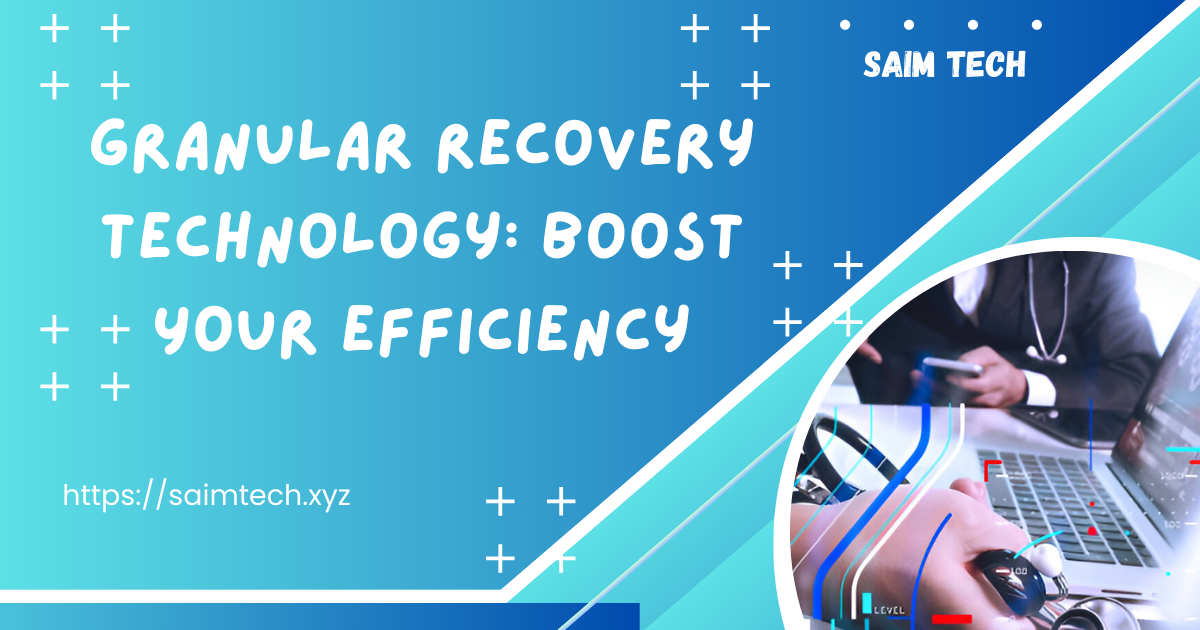Welcome to my Saim Tech blog! In today’s blog, we will explore how granular recovery technology can significantly enhance efficiency in various industries. If you are looking to optimize your processes and reduce waste, granular recovery could be the key to transforming your operations. Let’s dive into the details of this innovative technology and how it can benefit you.
What is Granular Recovery Technology?
Understanding the Basics of Granular Recovery
Granular recovery technology refers to the process of reclaiming valuable materials in granular or particulate form, often from waste or by-products. This technology is designed to extract usable materials from various industrial processes that would otherwise be discarded. It’s widely utilized in industries like mining, recycling, and waste management, where the recovery of materials can lead to more sustainable operations.
Key Components of Granular Recovery Systems
Granular recovery systems are composed of specialized equipment that includes machinery for sieving, filtering, and sorting materials. Additionally, these systems often incorporate process optimization algorithms that improve efficiency by automating sorting and recovery. With these components working together, granular recovery systems can recover materials with greater precision and speed.
How Granular Recovery Technology Works
The Recovery Process Explained
Granular recovery technology operates using a variety of physical processes to extract valuable materials from waste. Sieving is one of the main techniques, where materials are separated based on particle size. Filtration further refines this by removing unwanted substances. Magnetic separation is another key process that uses magnets to remove ferrous metals, leaving only the desired materials. By utilizing these methods, granular recovery technology ensures that valuable materials are efficiently reclaimed.
Automation and Monitoring in Granular Recovery
To ensure optimal performance, many modern granular recovery systems are equipped with automation and real-time monitoring capabilities. These features allow systems to operate with minimal human intervention while maintaining high recovery rates and consistent material quality. Automation helps reduce human error, making the process more reliable and efficient, and real-time monitoring ensures any issues can be addressed immediately to maintain smooth operations.
Benefits of Granular Recovery Technology
Enhanced Efficiency in Production
One of the main benefits of granular recovery technology is the increased efficiency it brings to production processes. By recovering valuable materials, companies can reduce the amount of waste generated, which in turn minimizes production downtime and maximizes resource utilization. With materials being reclaimed and reused, businesses can enhance their overall productivity while reducing costs associated with raw material procurement.
Environmental and Economic Advantages
Granular recovery technology provides significant environmental benefits by reducing the amount of waste that ends up in landfills. This contributes to a more sustainable business model and supports eco-friendly practices. On the economic side, businesses can save money by reusing materials that would otherwise need to be sourced, thereby lowering their operational costs. The long-term savings through the recycling of materials are substantial, making granular recovery a wise investment for businesses looking to improve their bottom line.
Applications of Granular Recovery Technology
Industrial Use Cases
Granular recovery technology finds widespread application in industries like mining, recycling, and agriculture. In mining, it’s used to extract valuable ores and minerals from waste. In recycling, it helps reclaim plastics, metals, and other materials from discarded products. Agricultural operations also benefit from granular recovery, as it aids in processing organic waste and recovering usable components from agricultural by-products.
Applications in Waste Management
In waste management, granular recovery plays a vital role in sorting and separating various waste components, which can then be recycled or disposed of properly. It helps ensure that waste materials are processed efficiently, with as much recovery as possible, reducing the burden on landfills and supporting a circular economy.
Challenges and Considerations in Granular Recovery Technology
Technical and Operational Challenges
Despite its benefits, granular recovery technology comes with challenges. For one, the initial investment in specialized equipment can be significant. Furthermore, the technology requires high energy input and can be complex to manage, especially when dealing with different types of materials. Businesses need to ensure they have the right technical expertise to operate and maintain these systems effectively.
Overcoming Granular Recovery Challenges
To overcome these challenges, companies need to invest in advanced technology and ensure that their staff is properly trained. Regular maintenance of equipment is also crucial to ensure optimal performance. Additionally, technological advancements and system improvements continue to make granular recovery more efficient and cost-effective over time.
Future of Granular Recovery Technology
Innovations and Advancements
The future of granular recovery technology looks promising as ongoing research and development lead to innovations that improve efficiency and scalability. Companies are investing in new technologies that further enhance the precision and effectiveness of material recovery, reducing waste and maximizing the recovery rate.
The Growing Role of Automation and AI
As industries seek to streamline their operations, automation and artificial intelligence (AI) are becoming increasingly important in granular recovery systems. AI can help optimize the sorting process, while automation ensures that systems run smoothly without constant human intervention. These technologies are expected to make granular recovery systems more efficient and effective in the years to come.
Conclusion
Why Granular Recovery Technology is a Game Changer
Granular recovery technology is more than just a trend; it is a game changer for industries aiming to enhance efficiency, reduce waste, and promote sustainability. By incorporating granular recovery systems into their operations, businesses can not only improve their bottom line but also contribute to a greener, more sustainable future.
FAQs About Granular Recovery Technology
What Industries Benefit Most from Granular Recovery?
Industries such as mining, recycling, and waste management benefit significantly from granular recovery technology, as it helps reduce waste and reclaim valuable materials. These industries can use granular recovery to optimize their processes, minimize material loss, and boost sustainability efforts.
Is Granular Recovery Technology Expensive?
While the initial investment in granular recovery technology can be substantial, the long-term savings through material recovery and reduced waste management costs make it a cost-effective solution. The technology’s ability to recover valuable materials and reduce material waste leads to significant cost savings over time.
Can Granular Recovery Technology Be Used in Small-Scale Operations?
Yes, granular recovery systems can be scaled to fit both large industrial operations and smaller businesses. While large operations may require more advanced systems, smaller companies can benefit from scaled-down versions that fit their needs and budget. This makes granular recovery technology versatile across a range of operational sizes.

